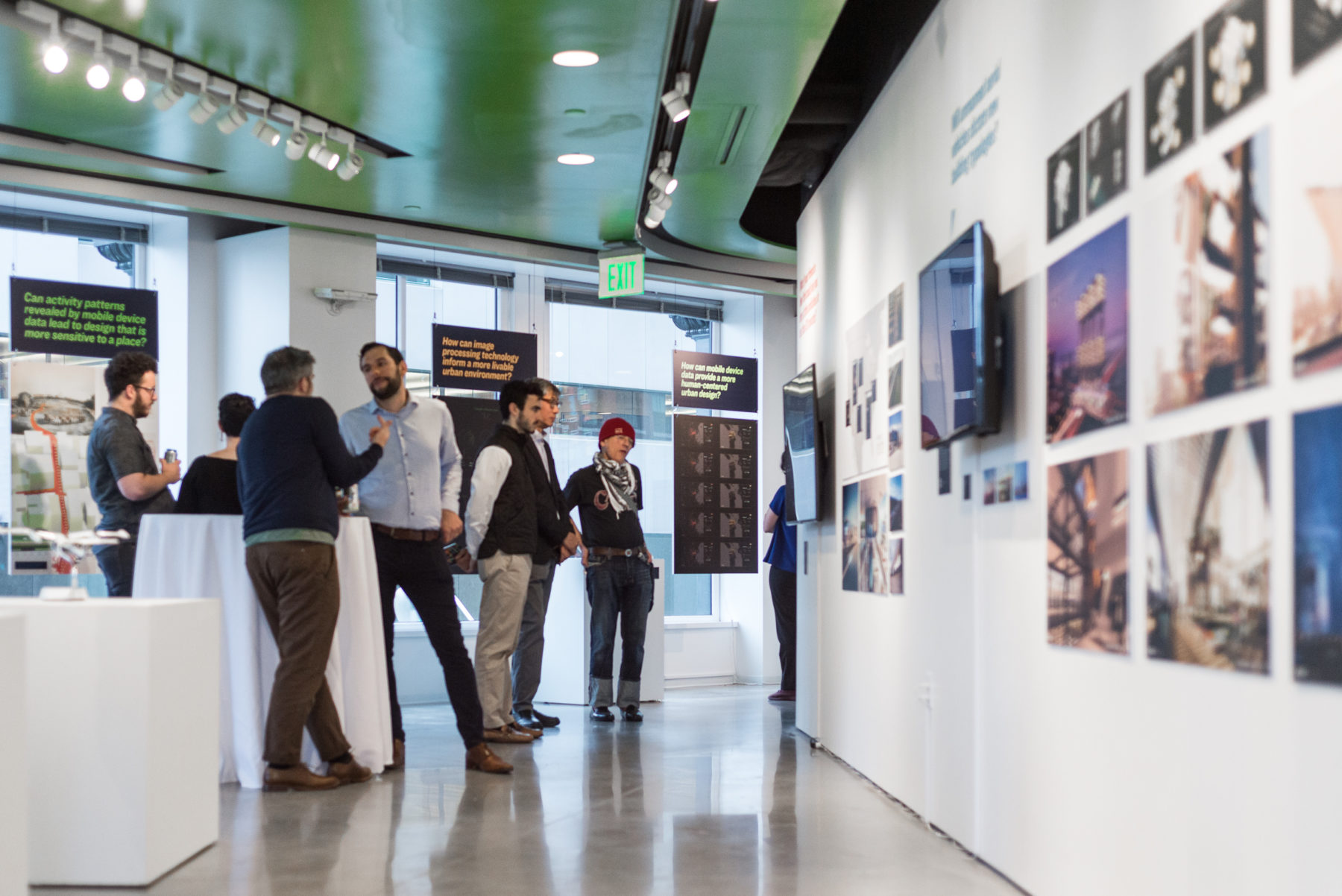Review of Balancing Act: Urbanism & Emerging Technologies

Assembling a coherent picture of urbanism and emerging technologies is a valiant, Sisyphean task.
Cities are anxious to boast of Smart City “solutions” to their problems—without fully understanding the Smart City, the solutions, or the problems parts of the equation. At the same time, many citizens struggle to understand this realm of urbanism and how they and their data footprint fits and feeds into it.
The BSA Space’s latest exhibition, Balancing Act: Urbanism & Emerging Technologies (Balancing Act), steps bravely into this realm. The firm behind Balancing Act, CBT Architects, recognizes that there are more questions than definitive answers at this relatively early juncture between urbanism and technology, and aptly places a vehicle for such questions and debate at the opening of the show.
“Perspectives,” a compilation of interviews with practitioners, academics, and urban citizens young and old share their opinions and personal questions on various facets of personal and public technology in the urban realm.
In one of the videos, Eric Gordon, Researcher and Civic Designer from the Engagement Lab at Emerson College, identifies one of the main issues of technology in the urban realm. “There are two questions we need to ask: ‘Is it the right tool for the job?’ and ‘Is the job the right one?’ We should be asking is the job the right one. Is this future city that we imagine the future city we all want?"
His questions set a litmus test early on that frames both the exhibition’s features and fallacies in its curation. There is a wealth of right tools for the right job on display, but also plenty of jobs that seem to be solutions in search of a problem.
Public Square by FXCollaborative excels in providing right tools for the job of creating a future city we want. Preparing for a time when autonomous vehicles have made parking spaces and public parking structures obsolete, Public Square provides “a way to rethink their streets and reclaim that parking space for a greener, more walkable, bike-friendly, and lively public realm.” The project isn’t technological in nature, but responsive to the urban impact of emerging technologies, which gives it added resonance in the overall context of the exhibition.
Strengthening the pragmatic, problem-solving offerings of the exhibition is City Scanner by MIT’s Senseable City Lab, a device that can be attached to municipal vehicles to capture and map air and road quality as the vehicles move throughout the city. Similarly, Underworlds, also by the prodigious Senseable City Lab, integrates technological innovation with where we’re at right now to steer us towards a better future. As the project explains, “Underworlds is an open-data platform for monitoring urban health patterns in sewage, advancing the potential of urban epidemiology.”
The more the exhibition unfolds, the more certain questions and observations echo from the Perspectives video. In one of his video interviews, Daniel O’Brien, Urban Scientist at Northeastern University and the Boston Area Research Initiative, nails the central dilemma of urban tech: “A lot of technology is built right now with two impulses: efficiency and ‘that would be cool’.”
For all of the projects in Balancing Act that carry considerable weight in their efficiency and practical application, there are those that seem to be in the show on the strength of their “that would be cool” factor.
The exhibition’s Current Forces “interactive” projection, a model display for placing that-would-be-cool technology before considerations of user experience, appears near the Perspectives video wall, but a mile away from its grounded offering. The displays contain a tremendous amount of data to try and help the public explore “many ideas―or innovative concepts―about the future” in the fields of mobility, material/manufacturing, energy/power, and agriculture/water, and how they are connected. Yet ultimately, as the gallery visitor navigates the information-dense projected graphic with a single scroll wheel, any specifically desired information, when finally reached, disappears in a timed sequence before the text can be read because the duration of its display and opportunity for contemplation is beyond the user’s control.
Another cool-factor culprit waits in the curve of the gallery. Sky Tower by Pickard Chilton, ARUP, and Uber, “a concept design for a Mega-Skyport—Uber’s vision for a next-generation urban aviation transport system.” The unwarranted real estate the project takes up in the exhibition, complete with a model, futuristic renderings, and text lacking much-needed critical commentary, leaves the visitor wondering if the “Sponsored by Uber” tag simply fell off the wall at some point.
Fortunately, the exhibition is good a righting itself amidst the ebb and flow of uneven curation. It excels in its inclusion of more grounded projects that balance the right tool and right tool for the job matrix.
Projects like Urban Network Analysis by Andres Sevtsuk, of the City Form Lab at Harvard GSD, illustrates the efficiency in O’Brien’s quote exceptionally well. The Urban Network Analysis toolbox provides “powerful methods for analyzing spatial accessibility, pedestrian flow and facility patronage along spatial networks.” These tools made available to architects, urban planners and designers enable fast, iterative responses when planning or designing future urban developments.
Two projects by Daniel Fink of Placeful Technologies also offer some much-needed abilities to open up usually opaque urban issues. Fink’s Understanding Housing Development is an interactive engagement app that illustrates the effects, opportunities, and trade-offs involved in residential real estate development. His Computing Co-Operative Development offers “Mass accessibility to urban data, design computation, and digitized financing [that] will reshape real estate development and our engagement with the city.”
Yet both of Fink’s projects exist in the exhibition as dense theses presented literally in book form. Time spent unpacking and making these ideas more accessible and visual would have been a good curatorial investment.
Stepping back to consider Balancing Act as a whole, its imbalanced and more-questions-than-answers curation isn’t an entirely bad thing. The public and professional mix of the BSA Space Gallery’s visitors is a good audience for posits and provocations put on display for a range of different interests and levels of understanding.
The key eras that define the history of urbanism and the urban landscape are fixed in time, bookended between years and tomes of study and assessment. The era of emerging tech and urbanism isn’t even in its opening acts as far as what it will do in time—cities are still in the read-through, urban planners auditioning for parts.
Balancing Act offers some satisfying first drafts of what is to come.

